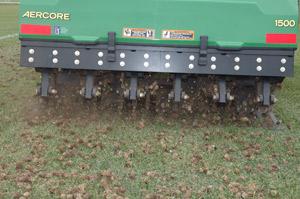Fall Preparation and Field Management
Written By: Ken Mrock, Head Groundskeeper of the Chicago Bears
 Not everyone looks at field maintenance as an ongoing process, and there are sometimes understandable limitations with budget and available resources. In a situation where a field manager is just getting out on the turf shortly before the players return for practice, there are some good techniques and effective ways to improve a field right before, or even during, a football or soccer season.
Not everyone looks at field maintenance as an ongoing process, and there are sometimes understandable limitations with budget and available resources. In a situation where a field manager is just getting out on the turf shortly before the players return for practice, there are some good techniques and effective ways to improve a field right before, or even during, a football or soccer season.
Tip #1: Perform a soil analysis
Understanding your soil is key to addressing issues and developing a full maintenance program. Measuring pH and nutrient levels, and making the necessary adjustments to balance the soil, can give you a head start on improving your root zone and the strength of your turf.
Tip #2: Implement or continue fertility program based on a soil test
Once you’ve identified issues or challenges inherent in the soil, you can adjust fertilization rates to ensure that the plant is getting the right nutrients and the right time for maximum vitality. For example, with cool season grasses, two thirds of the fertilizer for the entire year is typically applied in the fall.
Tip #3: Establish a seed bank
Begin overseeding your turf prior to the start of the season. Overseed weekly, but at lighter rates (as opposed to a heavy overseeding only once or twice a season). This allows for the establishment of a ‘seed bank’, through which you always have new germination to take the place of turf that is damaged from foot traffic.
 Tip #4: Aerification is the key to quality turfgrass
Tip #4: Aerification is the key to quality turfgrass
Soil compaction is one of the most common causes of weak turf on athletic fields. It is caused by soil particles being squeezed together by high traffic. Compaction reduces the rate at which water moves through the soil, and decreases air space. This prevents grass roots from functioning normally, so they become shallow and eventually die. The result is weak turf with little density and is more subject to injury. Aerification on a regular basis will help combat such problems.

Tip #5: Overseed after aerification
Seed must have good soil contact in order to thrive. One of the easiest ways to ensure this is to work seed down into aerification holes to promote root establishment. Establishing the grass plant within aerification holes will help to protect the grass plant from traffic.
Tip #6: Topdress with Field & Fairway™
On fields where you have existing turf and your grade is what you desire, core aerify in 3 to 4 directions to bring up as much growing medium as possible. Then, apply Field & Fairway at a rate of 750 pounds per 1,000 square feet across the entire area. Use a chain link drag, broom, or mat drag to break up soil cores and to move your conditioner into the aerification holes. Field & Fairway is an ideal amendment because it doesn’t break down over time, providing long-term benefit to your root zone. By aerifying and topdressing regularly, the Field & Fairway will allow the cores to break up much easier after each aerification, keeping the growing medium friable, and allowing it to effectively store nutrients and water.
Tip #7: Sharpen mower blades or reels
Poorly sharpened mower blades can be extremely damaging to the turf, causing the grass to be ripped instead of being sheered. Be sure to establish a mowing routine that keeps the grass at a manageable and playable height, while never removing more than one third of the leaf blade. If 2 inches is the desired height, mow before the grass reaches 3 inches.
Tip #8: Encourage players to practice on underutilized areas of the field to spread out wear
Goal line drills do not always need to be practiced right on the goal line! Your turf takes a beating between the hashes, especially near mid-field and near the goal lines. Move around the field for drills, even orienting the players toward the sidelines from time to time instead of moving across the yard lines. This will spread out wear and reduce turf damage.
 Tip #9: Promote effective turf repair and recovery
Tip #9: Promote effective turf repair and recovery
Protect the crowns of your grass plants with a simple application/topdressing of Field & Fairway prior to an event, especially if the soil is wet or rain is predicted during the contest. A suggested rate of 735 pounds per 1,000 square feet will give you an effective 1/4-inch layer of topdressing. In heavy traffic areas, broadcast your grass seed first, followed by Field & Fairway. The players will work the seed and conditioner into the surface for you. Not only does this reduce the amount of damage due to foot traffic, but it allows the turf to recover much more quickly.
Spot treat worn or muddy areas by dumping and raking Field & Fairway Emerald. The green coloring of the product provides aesthetic benefit, while the ceramic particles effectively soak up moisture and provide solid footing even through heavy rains. This is ideal treatment for high traffic areas between the hashes on a football field, or in a soccer goal mouth.
Tip #10: Utilize heavy, infrequent watering
Light frequent watering will not soak the soil and causes roots to stay near the surface and vulnerable to drought stress. Irrigating in the early morning is most effective because you reduce the evaporative effect while also allowing plenty of time for the turf to dry – reducing the likelihood of overnight disease.